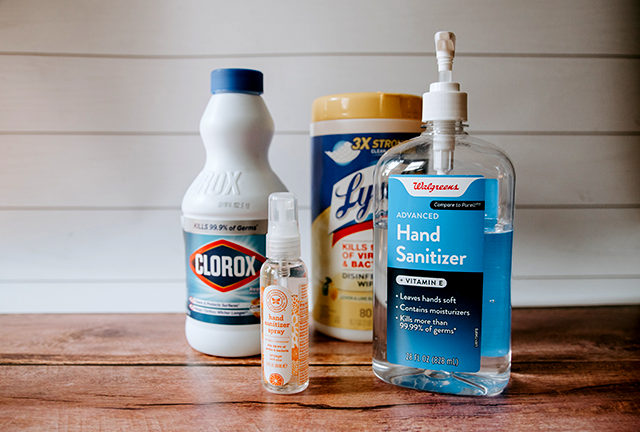Almost 40 percent of Americans have used bleach, disinfectants and other cleaning products in unsafe ways to protect themselves from COVID-19, the results of a new CDC survey suggest.
Those unsafe practices mostly involve washing food with bleach. But significant proportions of people have also done such high-risk things as intentionally ingesting or inhaling disinfectants or spraying household cleaners on their skin, the survey found.
The findings are both startling and troubling. “These practices pose a risk of severe tissue damage and corrosive injury and should be strictly avoided,” the CDC researchers warn in their report of the survey, which was published Friday in the agency’s Morbidity and Mortality Weekly Report (MMWR).
As the CDC revealed in May, poison control centers in the United States have experienced a sharp increase this year in calls about possible poisonings related to disinfectants and other cleaning products. The agency conducted the current survey to determine why those increased calls might be happening — specifically, to find out if people understand how to safely use these products to keep high-touch surfaces clean to protect against the spread of COVID-19.
In its report on the survey, the CDC does not refer to President Trump’s remarks at an April 23 press conference in which he posed the possibility that putting a disinfectant inside the body, perhaps through an injection, could kill the coronavirus. Health officials quickly put out warnings that injecting or ingesting bleach or any other disinfectant was dangerous. Later, the president said his remarks had been meant sarcastically, as a prank on journalists.
A knowledge deficit
CDC officials conducted the survey online with a nationally representative sample of 502 Americans, aged 18 to 86 (average age: 46), on May 4. Participants answered questions about their general knowledge, attitudes and practices related to their use of household cleaners and disinfectants, as well as about their specific application of such products to prevent the transmission of COVID-19.
The survey found that although a large majority of the respondents said they knew how to safely clean and disinfect their home, most didn’t. For example, 65 percent believed it was okay to mix bleach with vinegar, and 41 percent thought it was fine to mix it with ammonia. Furthermore, only 54 percent of the respondents thought that hand sanitizers should be kept out of the reach of children.
Cleaning and disinfection practices in the previous month with the intent of preventing SARS-CoV-2 infection, based on responses to an opt-in Internet panel survey (N = 502 respondents) — United States, May 2020

Those beliefs are potentially dangerous. Combining bleach with either vinegar or ammonia can release toxic vapors that can cause severe damage to the eyes and lungs. Nor is it safe to keep hand sanitizers where children can access them easily. As the American Academy of Pediatrics has warned, “swallowing just a tiny amount of hand sanitizer can cause alcohol poisoning in children.” (Improperly stored household cleaners and hand sanitizers also pose a danger to pets, the CDC researchers point out.)
The survey also revealed that many people are using household cleaners and disinfectants in disturbing — and unsafe — ways in an effort to protect themselves from COVID-19. These intentional practices included applying bleach to fruits, vegetables and other foods before eating them (19 percent), washing themselves with household cleaners or disinfectants (18 percent), misting their bodies with a cleaning or disinfectant spray (10 percent), inhaling vapors from a household cleaner or disinfectant (6 percent), and drinking or gargling diluted bleach or other cleaning solutions (4 percent).
A quarter of the people surveyed said they had experienced “an adverse health effect during the previous month that they believed had resulted from using cleaners or disinfectants,” the CDC researchers report. These included irritation to the eyes and skin, dizziness, headache, nausea and breathing problems.
Staying safe
The survey comes with caveats. Because it was an opt-in survey, it may not be truly representative of the entire U.S. population. the survey may also have some “social desirability” bias. For example, out of fear of seeming foolish, some respondents may have underreported their high-risk uses of household cleaners. In addition, the survey was taken on a single day and therefore may not reflect shifting attitudes and practices among the American public.

CDC officials say they are continuing to collect data so that they can develop better messages to “ensure safe cleaning and disinfection practices in U.S. households during and after the COVID-19 pandemic.” In the meantime, they urge everybody to stay safe while using household cleaners and disinfectants by always reading label instructions, wearing protective gear (gloves and goggles) and not mixing products together.
And, of course, use common sense. Don’t use bleach or any other household cleaner to wash your food or skin, and don’t inhale or ingest them, either.
FMI: You’ll find the report on the survey at the CDC’s website. The agency’s website also provides many more tips about the safe use of household cleaners and disinfectants.






“And, of course, use common sense.” Not necessarily. Common sense in one culture is not the same knowledge base as in another. There are also considerable variations by age and experience within a culture. Instead, we should strive to better educate everyone, hard as that may be in a country with such disparate educational systems.